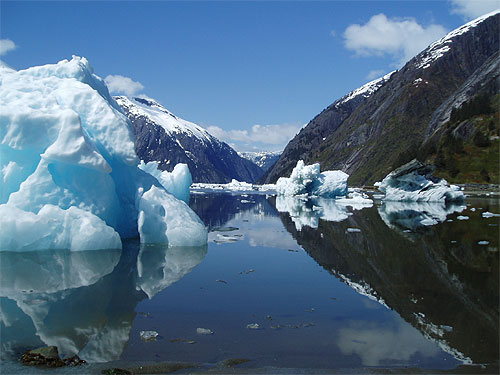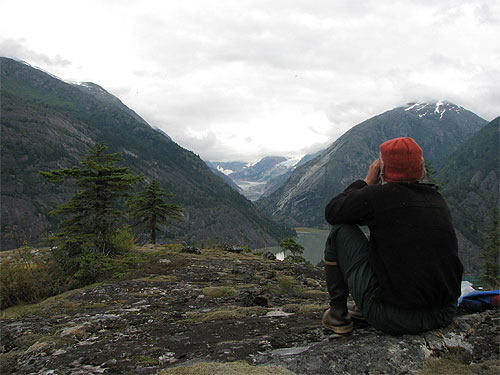 Story and photos TIM LYDON July 24, 2010
Each spring, I make my first trip of the year to the Tracy Arm-Fords Terror Wilderness, usually in late April or May. Depending on the weather, it's a two- or three-hour skiff ride about 50 miles from downtown Juneau, past the scenic openings of Taku Inlet, Taku Harbor, Limestone and Snettisham. With each mile, I grow eager to see how Tracy and Endicott Arms have survived the long winter. For 14 years, I've spent most of my summers in this area. It's where I work as a ranger for the Forest Service, where I spend some of my free time - kayaking, camping or just relaxing - and when family comes to Juneau, it's the first place I take them.
Photo by Tim Lydon
At the ends of the arms, three tidewater glaciers dump giant columns of ice into the sea. Water splashes hundreds of feet as the thunder from the massive shift rumbles between cliffs. My journey veers me eastward into Holkham Bay. I hit a wall of cool air and begin dodging ice bergs, some camouflaged in the blue-green ocean. A line of grounded bergs, with eagles and gulls atop their blue summits, marks the reef at the entrance to Tracy Arm. The ice here has drifted 30 miles from the tidewater glaciers at the head of the arm. I land on one of the small islands in the middle of Holkham Bay and walk up a beach of gravel and crushed shells. I sit on a rocky point and eat my lunch, listening to songbirds and the occasional breath of a humpback whale. To the north, the Sumdum Glacier hangs from a 7,000-foot peak, flowing into lush forest like a blue teardrop. Endicott Arm stretches between snowy peaks to the east. On the other side of Stephens Passage, the mountains of Admiralty Island slice across the western horizon. Whether it's scenery, wildlife, glaciers, or opportunities for recreation and solitude, Tracy and Endicott Arms truly have it all. Recognizing this, local conservationists pushed to preserve the area as wilderness in the 1970s. They succeeded in 1980, when Congress designated the Tracy Arm-Fords Terror Wilderness as part of the Alaska National Interest Lands Conservation Act, the law that created most of Alaska's parks and wilderness areas. Ten years later, while reforming timber practices on the Tongass National Forest, Congress created the adjacent Chuck River Wilderness. Together, the two wildernesses encompass about 730,000 acres around Holkham Bay and Tracy and Endicott Arms. As wilderness, the area offers people an opportunity to experience nature in a wild and undeveloped setting. The undeveloped part is key. Authors of the 1964 Wilderness Act knew that leaving certain parts of the national landscape undeveloped was essential to keeping Americans connected to the natural world that sustains us. They knew if places like Tracy and Endicott Arms were free from logging, homes and commercial lodges, that every generation would have an opportunity to connect with the magic of raw nature. While the glaciers at the ends of the arms attract all the notoriety, Holkham Bay offers some of the best camping and kayaking in all of Southeast. The scenery is an ever-shifting kaleidoscope of clouds, ocean, forest, ice and rock. Wildlife includes bears, whales, abundant birds and more. And Holkham is the only large bay on the mainland between Juneau and Frederick Sound that does not have any cabins, resorts, or other developments. Because most of the surrounding forest is designated as wilderness, it should stay this way, but questions remain about a few state and private parcels along the shore. After lunch, I roam the island, looking for news from the winter. It doesn't take long to find it. Near the island's summit, a 500-year-old spruce is sheared off at 40 feet. The great tree rotated half a turn in the wind before its mossy branches stabbed the ground. Nearby, in a dim grotto beneath crumbly cliffs, green-tinted bones mark where a Sitka black-tail sought a quiet place to die. And at the far end of the island I find a feather from a snowy owl, an uncommon winter visitor to Southeast Alaska. The bones, feather and broken tree are like stories from a friend I haven't seen all winter. And in the coming days, as I kayak in Tracy and Endicott Arms, more stories come to light. One evening, while camping on an island near my favorite meadow, I see that one of the local brown bears had a litter of three cubs this winter, born and nursed in the snowy mountains above Tracy Arm. I watch them through binoculars, running and wrestling in the meadow as their mother grazes.  Photo by Tim Lydon
Near the glaciers, the freeze-thaw cycles of late winter flaked big chunks of schist and granite from the vertical mountains. They left bright scars on otherwise weathered cliffs and piles of debris crammed in narrow gorges. It's like this every spring when I return to the fiords. One year I found that a winter gust leveled hundreds of trees alongside Endicott Arm. Another year, above-average avalanches widened existing slide paths, and I counted the remains of eight mountain goats caught up in their debris piles. As I run through these memories, ordinarily slow geologic changes occur with the speed of a flip-book. I realize that Tracy and Endicott Arms are uniquely dynamic places. Spring is an exciting time to visit the fiords. Winter's tales are written across the landscape, often conveying the lesson that life is short. Yet, signs of renewal are just as widespread. Forbs magically rise from the brown earth, spruce tips brightly beam from the forest's edge and eagles circle in pairs. The promise of summer stretches ahead, full of long days and new adventures in the natural world. To me, the best way to visit is by kayak. The ocean is usually calm and camping alongside the water affords spectacular views.
Source:
Publish A Letter in SitNews Read Letters/Opinions
|
